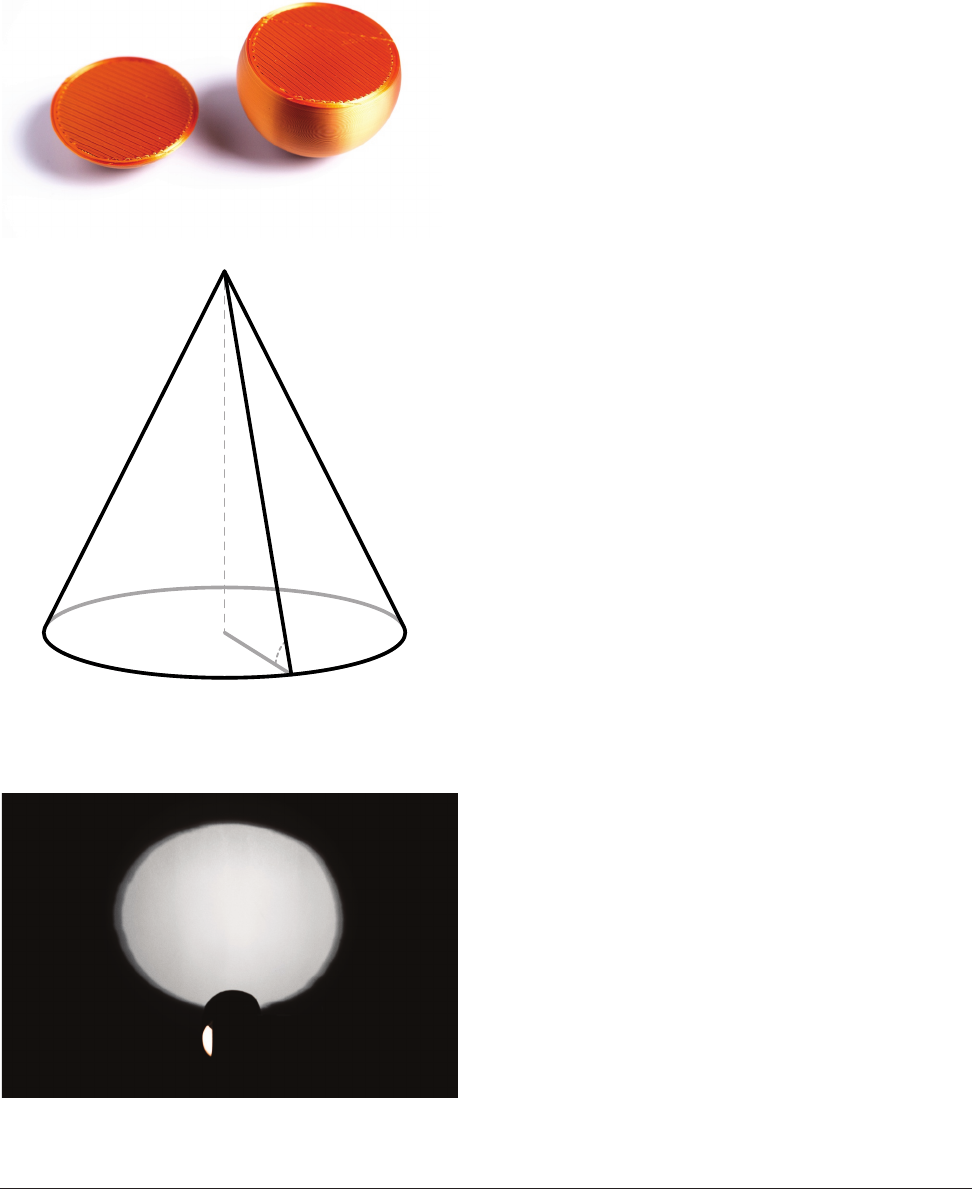
HEXAGONAL
(
6-SIDED
)
CROSS-SECTION
To get a 6-sided cross-section, our plane needs to intersect all six sides of
the cube. That means that the cut needs to go through the top, bottom, and
all four sides. One way to do that is to imagine that you have the cube bal-
anced on one of its vertices, with the plane parallel to the ground.
As you raise the plane above the ground, initially you will have a triangular
cross-section. As you continue to raise the plane parallel to the base of the
cube, though, eventually it will reach the point where it intersects all six
sides. If you start with a cube sitting on one face on a table and rotate it 55
degrees around one of the axes in the plane of the table, you’ll have it on
one corner. Therefore, to get the hexagonal cross-section in Figure 10-4, we
used:
sliceangle = [55, 0, 0] and
sliceheight = h / 2
COMPARING CASES
If we were to compare all these cases, assembling the cubes from the
one with a triangular cross-section through the one with the hexagonal
cross-section, what would we notice?
Most of the cross-sections will not be regular polygons (that is, shapes with
all the sides the same). To get a regular polygon, the cutting plane would
have to intersect each side of the cube for the same distance, which only
happens for certain angles and axes of rotation of the cutting plane.
Examine the different polygons and make observations about the angles at
which the sides come together. How would you orient the plane through a cube
to make a square versus a rectangle? (Answer: a cube would require cutting
through parallel to a face.)
SLICING OTHER PRISMS
A cube is a special case of a prism (a polygon with parallel top and base, and
n sides). For a cube, n = 4. A 4-sided regular polygon is a square, and extrud-
ing it gives you a square prism. To make that square prism a cube though,
you need to make the square’s sides equal to the prism’s height. Since we
are using the cylinder primitive in OpenSCAD, and it requires us to specify a
radius, we need to calculate the radius of the square.
Make: Geometry 203
Geometry_Chapter10_v15.indd 203Geometry_Chapter10_v15.indd 203 6/23/2021 9:10:43 AM6/23/2021 9:10:43 AM

A regular polygon’s radius is the distance from its center to each vertex, and
its apothem is the minimum distance from its center to any side. The ratio
between these two values for an n-sided regular polygon is cos(180° / n).
Setting the radius to half of the prism’s height divided by this ratio means
that for any even number of sides, the width (measured from one flat side
to another) will be equal to the height. (This is the default in cross-sections.
scad.) See Chapter 7’s discussion about inscribed and circumscribed poly-
gons for the details.
FIGURE 105: 8-sided cross-section of prism
FIGURE 106: 7-sided cross section of prism
Make: Geometry 205
204 Chapter 10: Slicing and Sections
Geometry_Chapter10_v15.indd 204Geometry_Chapter10_v15.indd 204 6/23/2021 9:10:44 AM6/23/2021 9:10:44 AM

If you think about it, an n-sided prism has n+2
sides. This is also the maximum number of sides
a polygonal cross-section can have, for the same
reason that a cube can have at most a hexagonal
(6-sided) cross-section. Here are two examples,
and the appropriate parameters for cross-sec-
tion.scad. Figure 10-5 shows an 8-sided
cross-section, from a 6-sided (hexagonal) prism.
Figure 10-6 shows a 7-sided cut through a pen-
tagonal prism. (A hexagonal prism has a top and
bottom, so a total of 8 faces; a pentagonal prism
has a total of 7 faces.)
You might follow along with this by testing out the
OpenSCAD parameters we give for each example,
and seeing for yourself how the cross-sections
change as you play with the given parameters.
8-sided cross-section (Figure 10-5):
n = 6
sliceangle = [50, 0, 30]
sliceheight = h / 2
7-sided cross-section (Figure 10-6):
n = 5
sliceangle = [45, 0, 0]
sliceheight = h / 2
Finally, any right prism will have a rectangular cross-section if you slice it
from top to bottom. In Figure 10-7 our example was a pentagonal prism,
with a total of 7 sides including the top and bottom.
n = 5 (but any value will work)
sliceangle = [90, 0, 0]
sliceheight = h / 2
SLICING A CYLINDER
Imagine that we make prisms that have more and more sides. Each side
gets shorter, and, as we saw in Chapter 7 for polygons and circles, the prism
starts to approach a cylinder. Cutting straight across it (with the plane par-
allel to the base of the cylinder) will give us a circle. Cutting through it at an
angle will give us an ellipse, which is like a circle that is stretched out along
FIGURE 107: Rectangular-sided cross-section of prism
FIGURE 108: Elliptical cross-section of a cylinder.
Make: Geometry 205
Geometry_Chapter10_v15.indd 205Geometry_Chapter10_v15.indd 205 6/23/2021 9:10:44 AM6/23/2021 9:10:44 AM

the other axis. We will learn more about ellipses
later in this chapter.
If the angle is too large for the cylinder’s height,
one or both ends of the ellipse will be chopped off
where it intersects the ends. If we rotate all the
way to 90 degrees, the sides will become straight,
and we’ll get a rectangle, just as we saw for the
prism. To create the model in Figure 10-8, use
these parameters:
n = 100
sliceangle = [30, 0, 0]
sliceheight = h / 2
SLICING A SPHERE
Imagine you have a sphere. If you cut it with a
knife, what does the slice look like? No matter
how you cut through a sphere, you will get a
circular cross-section (Figure 10-9). All cuts
through the center will be identical circles, and
cuts that don’t go through the center will also be
circles, but smaller ones.
Since a sphere is perfectly symmetrical around
its center, the angle of the cut doesn’t matter.
All that matters is the distance from the center
of the sphere to the closest point on the cutting
plane. You can see a sliced sphere in this photo
from model sphere_section.scad.
The model has just two parameters: size,
which is the sphere’s diameter (in mm), and
sliceheight, which is how far from the center
of the sphere the cutting plane is intersecting it.
CONIC SECTIONS
When we cut prisms earlier in the chapter,
we always wound up with another polyhedral
cross-section. When we cut a cylinder, we got
a circle or an ellipse (or a rectangle, if we cut
through it perpendicular to the base). Cones
are a bit more complicated, though. The conic
Slant height
Slant angle
FIGURE 109: A sliced sphere
FIGURE 1011: A flashlight making a circle on a wall (slightly
distorted by tube and photo angle)
FIGURE 1010: Slant angle and slant height
Make: Geometry 207
206 Chapter 10: Slicing and Sections
Geometry_Chapter10_v15.indd 206Geometry_Chapter10_v15.indd 206 6/23/2021 9:10:46 AM6/23/2021 9:10:46 AM

sections resulting from slicing through a cone with a plane are circles and
ellipses, along with two new shapes: parabolas and hyperbolas. (Hyperbo-
las require two cones arranged point-to-point, but we’ll get to that later.) As
we’ll see, we can predict, based on the angle of the cut, which of the conic
sections we will get.
First, we’ll do a simple experiment with a flashlight. Then we will go through
a 3D printed model of a set of all the conic sections, then experiment a bit
with making one cut at a time.
Chapter 11 will explore ways to construct the conic sections, tied to situ-
ations where the conic sections come up in real life. Actually deriving the
equations creeps a bit too far into the pre-calculus world for this book, but
we will give you pointers to other resources if you want to go that far.
Speaking of math we need, in the rest of the chapter, we will use the Pythago-
rean Theorem and the trigonometric functions (sine, cosine, and tangent) a lot,
so you might need to dip back into Chapter 6 a bit first for a refresher.
SLANT ANGLE AND SLANT HEIGHT
The slant angle of a cone is the angle the side of the cone makes with the
base. If we have the height, h, of the cone, and the radius of the base, we
know that the tangent of the slant angle has to be the height divided by the
radius.
Slant angle = tan
-1
(height/radius)
Note that some books measure the angle of the cutting plane relative to
the vertical axis of the cone, so be sure and know what convention a book
is using if you read about conic sections. We will measure the angle from
the base of the cone, with some y- or z-axis offsets of the cutting planes in
some examples to make various points.
The slant height is the distance from the base of the cone to the vertex, along
a side. It is the hypotenuse of the triangle made by the base and the height
(Figure 10-10). From the Pythagorean Theorem,
Slant height = √
r+h
Make: Geometry 207
Geometry_Chapter10_v15.indd 207Geometry_Chapter10_v15.indd 207 6/23/2021 9:10:46 AM6/23/2021 9:10:46 AM
..................Content has been hidden....................
You can't read the all page of ebook, please click here login for view all page.
